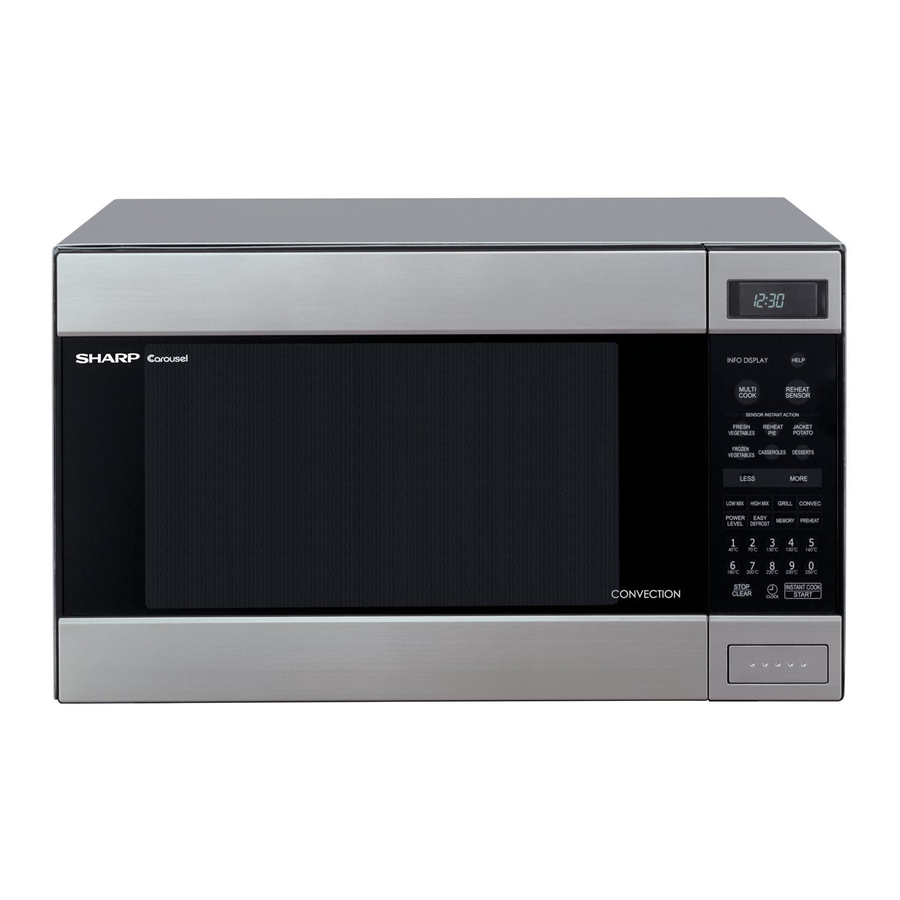Sharp Carousel R-990K Service Manual - Page 15
Browse online or download pdf Service Manual for Microwave Oven Sharp Carousel R-990K. Sharp Carousel R-990K 48 pages. Convection microwave oven
Also for Sharp Carousel R-990K: Operation Manual (41 pages)

[5] Procedure E: SWITCH TEST
CARRY OUT 3D CHECKS.
Isolate the switch to be tested and using an ohmmeter check between the terminals as described in the following table.
Plunger Operation
Common terminal to Normally open terminal
Released
Depressed
If incorrect readings are obtained, make the necessary switch adjustment or replace the switch.
CARRY OUT 4R CHECKS.
[6] Procedure F: FUSE F10A
CARRY OUT 3D CHECKS.
1. If the fuse F10A is blown, there could be shorts or grounds in electrical parts or wire harness. Check them and replace the defective parts or repair
the wire harness.
2. If the fuse F10A is blown when the door is opened, check the upper latch switch, lower latch switch and monitor switch.
If the fuse F10A is blown by incorrect door switching, replace the defective switch(es) and the fuse F10A.
CARRY OUT 4R CHECKS.
CAUTION: Only replace fuse with the correct value replacement.
[7] Procedure G: TEMPERATURE FUSE AND TERMAL CUT-OUT TEST
CARRY OUT 3D CHECKS.
Disconnect the leads from the terminals of the temp. fuse or thermal cut-out. Then using an ohmmeter, make a continuity test across the two termi-
nals as described in the table below.
Parts Name
Temperature fuse 150°C (MG)
Thermal cut-out 145°C (MG)
Thermal cut-out 150°C (CONV.)
Thermal cut-out 95°C (FAN)
If incorrect readings are obtained, replace the temp. fuse or thermal cut-out.;
An open circuit temperature fuse 150°C (MG)/ thermal cut-out 145°C (MG) indicates that the magnetron has overheated, this may be due to resis-
tricted ventilation, cooling fan failure or a fault condition within the magnetron or HV circuit.
An open circuit thermal cut-out 150°C (CONV.) indicates that the convection motor has over heated, this may be due to convection motor locked.
An open circuit thermal cut-out 95°C (FM) indicates that the fan motor winding has overheated, this may be due to blocked ventilation or locked cool-
ing fan.
CARRY OUT 4R CHECKS.
[8] Procedure H: CONVECTION HEATER TEST
CARRY OUT 3D CHECKS.
Before carrying out the following tests make sure the heater is fully cool.
1. Resistance of heater
Disconnect the wire leads to the heater to be tested. Using ohmmeter with low resistance range.
Check the resistance across the terminals of the heater.
The resistance of heater is approximately 37.5 ohms.
2. Insulation resistance
Disconnect the wire leads to the heater to be tested. Check the insulation resistance between the element and cavity using a 500V - 100M ohms
insulation tester. The insulation resistance should be more than 10M ohms in the cold start.
If the results of above test 1 and/or 2 are out of above specifications, the heater is probably faulty and should be replaced.
CARRY OUT 4R CHECKS.
[9] Procedure I: THERMISTOR TEST
CARRY OUT 3D CHECKS.
Disconnect connector-E from the CPU unit. Measure the resistance of the thermistor with an ohmmeter. Connect the ohmmeter leads to Pin No's E-3
and E-4 of the thermistor harness.
Table: Terminal Connection of Switch
Open circuit
Short circuit
Table: Temperature Fuse and Thermal cut-out Test
Temperature of "ON" condition
(closed circuit).
This is not resetable type.
This is not resetable type.
Below 130°C
Below 75°C
Common terminal to Normally close terminal
Short circuit
Open circuit.
Temperature of "OFF" condition
(open circuit).
Above 150°C
Above 145°C
Above 150°C
Above 95°C
8 – 3
R990K(W)
Indication of ohmmeter (When room
temperature is approx. 20°C.)
Closed circuit
Closed circuit
Closed circuit
Closed circuit
